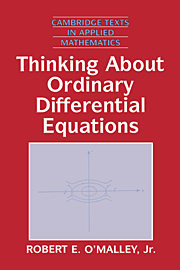Preface
Published online by Cambridge University Press: 05 June 2012
Summary
This small book is intended for use by students in the applied sciences and engineering who already have some elementary knowledge of ordinary differential equations. It aims to emphasize the variety of analytical approaches available and to teach simple techniques to use in their own technical work and in understanding the behavior of solutions to many standard problems. The exercises at the end of each chapter, in particular, are intended to be the primary learning tool, so fairly detailed solutions are provided for many of them. The important job of interpreting solutions in their underlying physical context is left to the reader.
Good calculus skills are called for. Some familiarity with numerical and/or symbolic computing and with matrix analysis would also be helpful, but is not necessary. We will not hesitate to introduce needed theory, without proof, in order to advance the reader's understanding. The fundamental perspective is that there is no best way to solve a given ordinary differential equation. Indeed, most equations that scientists encounter are solved numerically, and the traditional analytical techniques presented here remain important because they provide the basis for successful computing schemes. Readers are definitely urged to use available software to learn about the solutions of the differential equations they either need to solve or have otherwise become fascinated by.
The examples and exercises included have been collected over many years for various classes given by the author. Many were taken from others' textbooks and papers (only a few are original), so it is no longer possible to properly acknowledge the original sources.
- Type
- Chapter
- Information
- Thinking about Ordinary Differential Equations , pp. ix - xPublisher: Cambridge University PressPrint publication year: 1997



